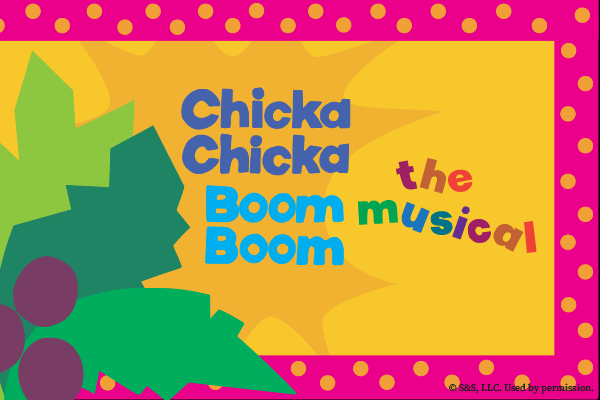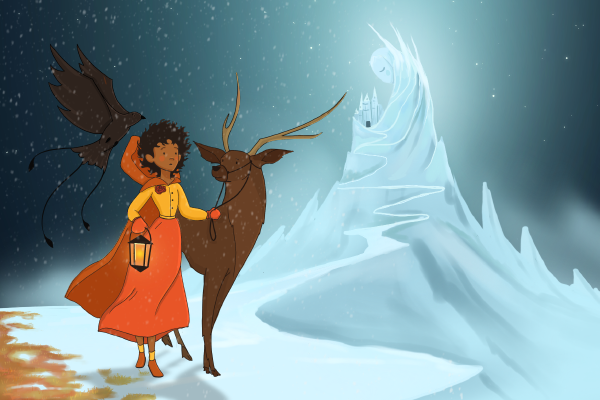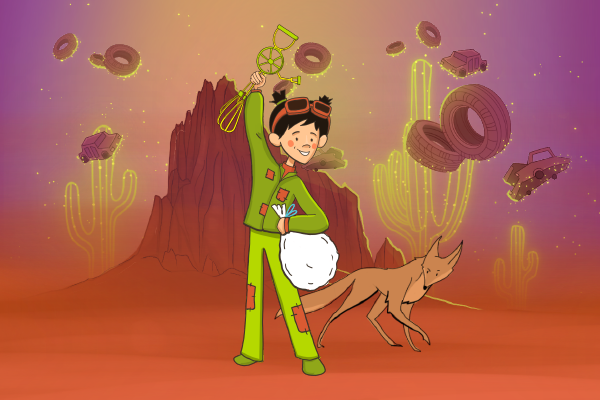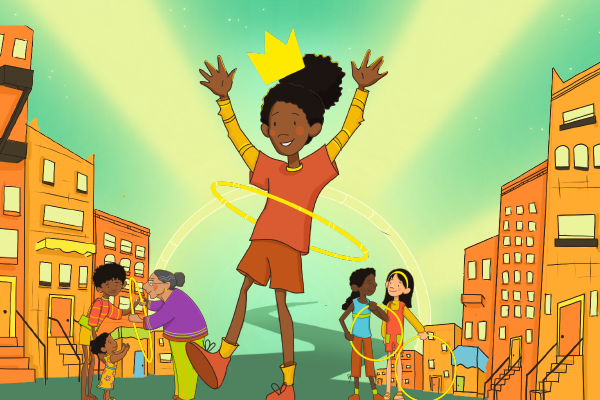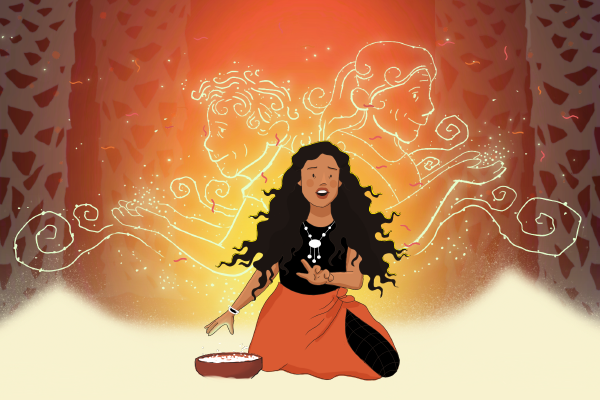Content Guidance
At Seattle Children’s Theatre, we love to be in conversation with our audiences. It is essential to our 50-year commitment to artistic expression and community engagement. We are proud to make art for and with our community.
Our content guidance page is intended to enable all audiences, caregivers, and educators to engage with the production and encourage conversations before and after the show.
25-25 Season
Cat Kid Comic Club: The Musical
September 18 - October 12, 2025
Content Note: COMING SOON
Learn more about this production in the drop down items below. For additional notes, see our Sensory Guide for Chicka Chicka Boom Boom: The Musical
Cat Kid Comic Club: The Musical is a lively, interactive production designed for children and families. The story explores themes of creativity, self-expression, and overcoming fears, all while maintaining a playful and humorous tone. The frogs’ comics include imaginative scenarios that range from silly to mischievous, to slightly macabre, always resolved in a positive and constructive manner. The play features elements of sibling rivalry and playful conflict.
CENSORSHIP
Censorship is just a big word for telling someone what they can and cannot say or do. In Cat Kid Comic Club: The Musical, Flippy tries to control what the kids write, making the kids feel like they cannot express who they really are in their comics. Flippy learns that he cannot write the kids’ story, and it’s better to let the kids find their own voices. It teaches us that allowing kids to express themselves and to be true to who they are is the best way to support them.
MENTORSHIP
Mentors are kind of like teachers. They teach us new things and cheer us on when we need support. The coolest part is anyone can be a mentor! Being a good mentor is not just about teaching, it is also about being there when someone needs you. In Cat Kid Comic Club: The Musical, Flippy learns that instead of trying to make the kids just like him, it is better to give them the tools they need to discover themselves.
POWER OF IMAGINATION
Inside all of us we have a seed of imagination. The seed is always there but without water it cannot grow. Cat Kid Comic Club: The Musical reminds us that imagination is worth watering and growing. The Cat Kid Comic Club is a space for the characters to grow their imagination from a seed into a beautiful flower and reminds us to take care of our own seed, water it and be proud of the beautiful flower of imagination we all have inside.
TOGETHERNESS _ COMMUNITIES CREATING TOGETHER
Cat Kid Comic Club: The Musical shows us how working together can make us closer. Most of the characters write their comics alone, but the whole club always presents them together for their audience. By working together, the kids find community with each other and become closer as a club. Watching the play, we learn that the power of making things together brings people closer, and stronger.
The play includes mild “gross out” language, such as “butt,” “poop,” and “boogers,” along with some lighthearted teasing and playful humor. There are also instances of schoolyard insults and ableist terms.
None
Cat Kid Comic Club: The Musical has moments of loud music, moving lights, and brief flashing lights. Audience responses or reactions can be noisy and potentially intense for some audience members. Reflections from a disco ball shine across the audience.
For additional notes, see our Sensory Guide available below.
The play begins with Cat Kid and Molly Pollywog introducing the audience to the chaotic world of their new club, where they aim to teach 21 baby frogs how to create their own comics. Each frog is bursting with energy, and Cat Kid promises that by the end of the week, everyone will have created a comic, with the reward of a “Mega-Gigantic, Humonga-normous Comic Club Party” awaiting their success.
As the frogs begin their creative journey, they struggle with self-doubt and fear of failure. The club’s first project, “Dennis the Toothbrush Lawyer for Dinosaurs,” is a collaborative effort that showcases the frogs’ wild imaginations. However, sibling rivalry flares up as Naomi and Melvin clash over their differing interests, leading to playful conflict and a series of comic creations that range from absurdly funny to slightly macabre, such as “Supa Fail!” and “The Cute, Little, Fluffy Cloud of Death.”
Despite these creative outbursts, Flippy, the frogs’ father, grows increasingly concerned about the content of the comics, particularly the recurring themes of destruction and dark humor. Tensions rise when Flippy imposes a rule that all comics must be “decent, wholesome, and with good moral values,” prompting a rebellion among the frogs. This conflict highlights the show’s exploration of creative freedom versus imposed restrictions.
As the week progresses, the frogs begin to find their unique voices. Starla, a shy frog, is encouraged to create a comic in haiku form, embracing her love for the Japanese art form. The final day brings a touching moment of reconciliation between Naomi and Melvin, as Melvin creates a comic from Naomi’s perspective, leading to a newfound understanding and respect between the siblings.
The play culminates in the much-anticipated Comic Club Party, where each frog presents their completed comic, celebrating the power of creativity, individuality, and the importance of embracing one’s unique talents. The story closes with the message that true creativity flourishes when fear of failure is overcome and self-expression is celebrated.
For a scene by scene breakdown, please see our Full Synopsis.
Havana Hop
October 16 - November 16, 2024
Learn more about this production in the drop down items below.
Learn more about this production in the drop down items below. For additional notes, see our Sensory Guide for Havana Hop.
Havana Hop is an upbeat one-woman production intended for multigenerational families. One actor plays multiple characters and addresses the audience directly throughout the play, which uses song and dance to explore family history. Attendees are invited to respond verbally and dance in their seats along with her. There are themes of identity, stories, self-confidence, and self-expression as Yeila takes inspiration from her mother, her Abuela, and her Cuban roots to take on a dancing contest, despite her stage fright, alongside the audience.
IDENTITY
People are like puzzles with our lives, stories, cultures acting like little puzzle pieces that all come together to make us the unique person we are. These pieces of ourselves are our superpowers because they help us understand how special we are, which only makes us stronger. Havana Hop shows the audience how different everyone’s puzzle pieces can be. By following Yeila in finding her roots, we see how all these different pieces of us make the person we are today, and the person that we hope to become.
FAMILY AND STORIES
Families are super special for people. Whether they’re the ones we are born into or the ones we choose, families connect us to our past and help us look toward the future. In Havana Hop Yeila learns more about herself by talking to her mom and Abuelita. By watching Yeila learn from the stories her mother and Abuelita tell, we see how listening to the stories our family shares can make us stronger.
SELF-CONFIDENCE AND OVERCOMING YOUR FEARS
In Havana Hop Yeila struggles being confident and facing her fears. In the play Yeila goes on an adventure to learn about all the different parts of her that make her special. As she finds out more about herself, Yeila becomes more confident and gains the courage to face her fears. Watching the show, we see how learning more about what makes us unique can make us strong and brave just like Yeila.
SELF-EXPRESSION
Havava Hop follows Yeila on an adventure of finding out what makes her unique. The play teaches us how knowing what makes you special and being proud to share that with the world is what makes us strong and brave.
Although primarily in English, Spanish is used regularly throughout the story, with English translations.
Abuela experiences memory loss, as a symptom of Alzheimer’s Disease, which is explained in the play.
Audience responses or reactions can be noisy and potentially intense for some audience members.
The play opens with Yeila engaging the audience against a backdrop of a Cuban flag projected in the night sky. She teaches them to wave their hands in response to a mysterious sound, creating an interactive atmosphere. Excited about performing at the Cherry Blossom Festival in Washington D.C., Yeila reveals her anxiety about auditioning, especially due to her stage fright.
To boost her confidence, she performs an energetic hip-hop dance and rap about self-love. As they arrive at the audition venue, filled with other artists, Yeila leads a warm-up session to energize everyone. However, when it’s her turn to audition, she freezes up. The judges still offer her a spot in the festival, but she must first explore her cultural roots.
Yeila rushes home to share her day, only to find her mother distressed over Yeila’s Abuela, who has Alzheimer’s and is losing her memories. Yeila learns from her mother about the importance of roots—raíz in Spanish—as a connection to heritage and self-discovery. Inspired, Yeila decides to research her Cuban culture with her mother’s help.
They plan a trip to Cuba, inviting the audience to join them on a joyful, interactive flight. Upon arriving in Havana, Yeila is enchanted by the sights and sounds. She creates a beat from her surroundings and starts speaking in Spanish. Her mother encourages the audience to engage in a bilingual call-and-response.
In Abuela’s courtyard, Yeila hears the mysterious sound again, realizing it represents her roots. She calls out for Abuela, who initially responds with confusion. After some coaxing and the mention of salsa dancing, Abuela begins to remember. Yeila’s mother leads the audience in a song that highlights the letters of Cuba—C for Culture, U for Unique, B for Beautiful, and A for Amazing—helping Abuela regain her memories.
As Abuela reconnects with her heritage, she inspires Yeila for her festival performance. After a touching moment where Abuela gives Yeila a flower for inspiration, Yeila returns to D.C. for the festival. Backstage, she finds comfort in the presence of her mother, Abuela, and her new friends.
On stage, Yeila performs a vibrant dance that celebrates her roots and newfound confidence, concluding the play on a triumphant note that emphasizes the power of cultural pride and self-acceptance. The audience cheers as Yeila’s journey comes full circle.
SCT's The Snow Queen
November 27 - January 5, 2025
Content note: This production includes themes of grief and use of a knife. It is a very visually dynamic production that may impact patrons who are sensitive to visual effects or moving lights.
Learn more about this production in the drop down items below. For additional notes, see our Sensory Guide for SCT's The Snow Queen
SCT’s The Snow Queen is a heartfelt exploration of love, chosen family, loss, and the resilience of the human spirit. The play follows one character’s suspenseful adventure in the name of friendship and love. Audiences can expect a fantastical experience created by projections, sounds, and theatre magic.
ADVENTURE
Adventure is not just exploring new worlds, but it can also be discovering new things about ourselves. Gerda in SCT’s The Snow Queen goes on a big adventure to save her friend. Her adventure shows us how we can be brave to stand for what’s right. However, we also can go on personal adventures. Kay in SCT’s The Snow Queen goes on a journey to learn about his feelings and how to find the courage to deal with them. Both journeys are important because they teach us that whether we are helping others or learning about ourselves, every adventure helps us learn and become stronger.
CONFIDENCE
Being confident can be hard at times, especially when we are scared. In SCT’s The Snow Queen Gerda finds that the parts of her that make her different are what make her strong. She teaches us what makes us different, does not make us weak, but strong and one-of-a-kind. When we learn this, then we can take on the world.
FRIENDSHIP
Friends can be kind and always cheer you on. They can also be someone who pushes you to be a better version of yourself. Friendship comes by making a safe space for others and helping them when they need it. As seen in SCT’s The Snow Queen, friendship looks different for everyone but is always important and worth fighting for.
LOVE
We are all able to give and receive love. Who we love, and how we show our love is always our own choice. In SCT’s The Snow Queen, Gerda shows us how love brings us together and gives us the strength to handle even the scariest of challenges. She teaches us that sometimes going above and beyond for love is always a good choice.
GRIEF
In SCT’s The Snow Queen, Kay loses his mother, and he becomes very sad and chooses to stay with the Snow Queen because she helps him feel nothing. Kay’s journey shows us how dealing with our sadness can be tough but helps us heal and find happiness. Like Kay, talking about hard things that make us sad can bring back warmth to our lives.
None
There is a scene in the play where a knife is wielded for protection.
The play includes several moments of grief, heightened emotions, and obsessive behaviors.
Has moments of loud music, moving lights, and brief flashing lights. Audience responses or reactions can be noisy and potentially intense for some audience members.
Supernatural themes including anthropomorphized animals and nature.
Visual projections and animated lights move throughout the production. The production includes a screen around both sides and the top of the set. Moving images are projected onto the screen throughout the entire show and, at times, projections cover the whole set. Every scene and transition utilizes the screen, and projections vary from moderate movement to very fast movement spinning, sweeping, and shaking. For a better sense of the projections, view our trailer for the production. For more information from our Sensory Audience Guide, coming soon.
SCT’s The Snow Queen is a play that follows the journey of two young friends, Kay and Gerda. The story opens with them joyfully creating a song atop their rooftops, but their playful moment is interrupted by a mysterious and enchanting melody from the roses, believed to be a hidden language of flowers. Their Grandma, calling them inside for dinner, hints at deeper emotions tied to Kay’s late mother, which Kay struggles to confront.
The mood shifts dramatically when the mesmerizing Snow Queen appears, bringing a heavy snowfall that symbolizes her enchanting yet chilling presence. As Kay becomes entranced by her, he begins to speak in numbers that echo the snowfall. The Snow Queen casts a spell over him, piercing his heart with ice, leading him to feel nothing but a cold emptiness. Despite Gerda’s pleas and Grandma’s warnings, Kay is swept away in the Snow Queen’s sleigh, heading north into eternal winter.
Weeks pass, and with no sign of Kay, Gerda becomes determined to find her lost friend. She bravely ventures out on her own, believing he may have drowned in the icy river. The river, responding to her grief, offers her a boat to continue her search. Along the way, Gerda meets a cheerful Sparrow who becomes her companion.
Gerda’s journey takes her to a magical garden where a mysterious Woman tries to keep her trapped by offering delicious berries. However, Gerda begins to feel the weight of time in the Woman’s garden, realizing she has lost track of days. With the help of singing flowers, Gerda escapes, driven by her unwavering love for Kay.
As Gerda navigates through various encounters—like a clever crow named Caw and a princess who shares tales of the Snow Queen—she learns about Kay’s plight. He is under the Snow Queen’s spell, unable to feel love or warmth. Despite the challenges, Gerda continues her quest, embodying the themes of courage, friendship, and the importance of emotional connection.
Gerda faces numerous trials, including being captured by a girl named Lumi. Yet, through compassion, she teaches Lumi about kindness and the importance of freedom. Gerda’s resolve leads her to the treacherous mountains where she bravely confronts the Snow Queen.
In a pivotal moment, Gerda’s tears—symbols of her love and grief—melt the ice around Kay, awakening him from his emotional stupor. This climactic reunion emphasizes the core message of the play: the strength found in vulnerability and the necessity of feeling one’s emotions.
Together, they journey back home, experiencing growth and healing along the way. As they return to Grandma, they are changed—older but enriched by their experiences. The play closes with a powerful reminder of the bonds of friendship and the importance of embracing one’s emotions.
For a scene by scene breakdown, please see our Full Synopsis.
The Girl Who Swallowed a Cactus
January 22 - February 2, 2025
Content guidance information will be available closer to the show. Check back later for more information!
COEXISTENCE AND UNDERSTANDING
Nature is all around us. The plants, the animals, sights, and smells remind us how we are part of a beautiful world bursting with wonder. But how we live with nature is up to us. The Girl Who Swallowed a Cactus shows us how if we are not careful, our choices can cause harm to the environment. Magical places are not just in stories, they live in nature around us, and it is up to us to protect it.
CURIOSITY AND CREATIVITY
In The Girl Who Swallowed a Cactus Sheila and her friends solve their problems with clever thinking and kindness. They always try to understand their problems to learn how to help. Sheila and her friends teach us that when we ask questions and work to understand our problems, we can solve anything.
ACTIVISM THROUGH ART
We can all make change. The Girl Who Swallowed a Cactus teaches us how we can use art to make changes in our world. Using the power of our mind, creativity, and heart we can make a difference.
For a scene by scene breakdown, please see our Full Synopsis.
The Hula-Hoopin' Queen
February 12 - March 9, 2025
Learn more about this production in the drop down items below. For additional notes, see our Sensory Guide for The Hula-Hoopin' Queen.
Three Harlem girls vie for the crown of Hula-Hoopin’ Queen, encouraged and mentored by the community elders in master playwright Gloria Bond Clunie’s spirited adaptation. This is a memory play, a play where we start in the present, then experience the events of the past. Kameeka relives the week she’s had, trying to balance her competitive nature with being kind, and making mistakes along the way. Audiences can look forward to a sweet, funny, and energetic slice of life reminder of the essential loops that bind our communities.
FRIENDSHIP
Friendship looks different for everyone but is always important and worth holding on to. Friends can be kind, always cheering you on or someone who pushes you to be a better version of yourself. In The Hula-Hoopin’ Queen Kameeka is shown how Jamara’s friendship makes her a stronger person. She also learns that true friendship comes when you bring everyone together and share your love and support. The play reminds us that good friends are there to make us strong and help us grow.
LOVE
We are all able to give and receive love. Who we love, and how we show our love is always our own choice. In The Hula-Hoopin’ Queen we see how love can be found in family, friends, and a community. Love brings us together and gives us the power to beat any challenge thrown our way. The play also reminds us that sometimes winning is not about competitions, but it’s about the people we care about and share our hearts with. When we are surrounded by the people we love, then we are all winning!
FAMILY AND COMMUNITY
Families are super special for people. Whether they’re the ones we are born into or the ones we choose, families are the people who care for us every step of the way. In The Hula-Hoopin’ Queen the audience sees how a community of people can be like a family too. When people come together to support, care, and love each other, a family-like bond can form and that is just as special.
COMPETITION
In The Hula-Hoopin’ Queen Kameeka works really hard to win a competition with her friend Jamara. Her determination to win shows how we when we work hard, we can achieve great things. But sometimes the important competition is with ourselves. We can challenge ourselves to become better, and stronger, and when we put in the effort to improve and grow, that is when we really win.
The Hula-Hoopin’ Queen has one instance of subtle suggestive humor.
This play has a feeling of high stakes for Kameeka, who feels the need to win her competition, but doesn’t want to disappoint her Mama or her community. The friends’ teasing sometimes crosses a line into put-downs.
The play has moments of loud music and lights that move and flash. The lights sweep across the audience in the beginning and end of the play.
There is one scene where we hear microphone feedback four times.
Audience responses or reactions can be noisy and potentially intense for some audience members
In the vibrant setting of present-day Harlem on 139th Street, The Hula-Hoopin’ Queen unfolds through the lens of community, family and friendship, love, and competition. The play opens with three energetic Hula-Hoopin’ Girls: Portia, Jamara, and Kameeka. Mama, and community elders Miz Adeline and Miss Evelyn, provide an underscoring beat while they dance and hoop.
Kameeka kicks the story off by asking, “How did I get here?” The scene transitions to a spirited competition among the girls, showcasing their hula-hooping prowess. As they vie for the title of Hula-Hoopin’ Queen, themes of greatness and personal identity emerge. Each girl defines greatness differently—Jamara through hula-hooping, Portia through her flute, and Kameeka, who feels uncertain about her own talents.
As the girls challenge Kameeka’s abilities, they agree to a showdown the following Saturday, with the winner claiming the crown and the loser completing chores for a month. However, Kameeka soon realizes that the competition coincides with Miz Adeline’s birthday party. Miz Adeline is important to Kameeka and everyone on the block. Kameeka’s desire to prove herself competes with her commitment to her friends and family.
Throughout the play, Kameeka seeks guidance from Miz Adeline, who imparts wisdom about the importance of practice and being true to oneself. Their bond deepens as they bond over hula-hooping and shelling peas, with Miz Adeline emphasizing that the essence of friendship lies in supporting and challenging one another.
As Kameeka prepares for the showdown, she skips doing chores like shopping that will help prepare for Miz Adeline’s birthday party. Kameeka tries to explain how important hooping is to her, but Mama says that’s no excuse, and reveals that she used to be a hooper herself. Kameeka’s hula-hooping aspirations are coming into conflict with her desire to celebrate her friend, Miz Adeline, with a big party including Miz Adeline’s favorite cake.
The competition day arrives, and Kameeka’s initial excitement is overshadowed by her responsibilities at the birthday party. As Kameeka grapples with her priorities, she ultimately decides to embrace both her commitment to her friend and her competitive spirit.
She joins her Mama in a rapid clean-up, getting everything ready for the party, hoping that if she’s fast enough she’ll make it to the competition on time. They succeed in getting almost everything done, and Mama is very proud of her, but they accidentally burn the cake. Kameeka runs out to get a bag of sugar so they can try to make a new cake in time for the party.
But on the way back, Kameeka gets pulled by her friends into the hooping competition. She can’t resist, especially when Jamara gloats about being the Queen. The sugar is set aside and forgotten as she competes with Jamara. Ultimately, she loses the competition when Portia runs into them both, knocking over not just all three girls, but the bag of sugar, which is all lost in the street. Jamara narrowly wins the competition, but Kameeka doesn’t care, too worried that this means there won’t be a birthday cake. She rushes home to Mama, who insists she should admit her mistake to Miz Adeline.
After realizing how she let Miz Adeline and everyone down, Kameeka creatively salvages the party with a delicious donut cake, reinforcing the play’s themes of community and love. Miz Adeline and Miss Evelyn wind up in a hula-hooping contest of their own, with everyone laughing together.
The story concludes with a joyful celebration. All the characters realize that they are all Queens in their own right, united through their shared experiences and love for each other. Although Jamara wins the contest, Kameeka learns that true victory lies not just in titles but in the relationships and love shared with friends.
For a scene by scene breakdown, please see our Full Synopsis.
The Pa'akai We Bring
May 7 - June 1, 2025
Content guidance information will be available closer to the show. Check back later for more information!
Sensory Guide coming soon!
FAMILY AND COMMUNITY
Families are super special for people. Whether they’re the ones we are born into or the ones we choose, families connect us to our past and help us look toward the future. In The Pa’akai We Bring we learn how the stories we share are a gift, something to be cherished, and shared with love.
GIVING
In The Pa’akai We Bring the act of giving is important, and something special. Watching this play we learn that by giving we spread joy and bring happiness to others and ourselves.
ENVIRONMENTAL STEWARDSHIP
The planet around us provides everything we need to be happy and healthy. In The Pa’akai We Bring we learn that our world takes care of us, and it’s our job to care for it and show it respect in return.
Have more questions?
Please reach out to hello@sct.org and we'll get back to you soon.


